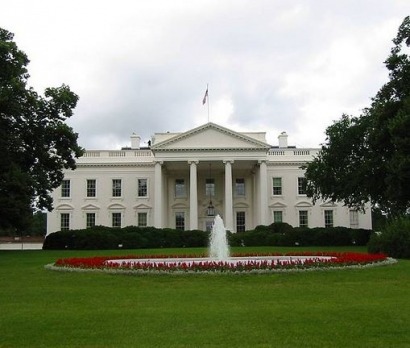
As first reported in The Washington Post, the installation of the rooftop photovoltaic system is part of a broader energy retrofit intended to improve the overall energy efficiency of the 213 year old building.
In an email exchange with the Post, an unnamed administration official said the project "will help demonstrate that historic buildings can incorporate solar energy and energy efficiency upgrades."
The official added the retrofit, which also includes installing updated building controls and variable speed fans, will pay for itself in energy savings over the next eight years.
In 1979, President Jimmy Carter became the first president to deploy solar panels on the White House, in his case installing 32 panels to provide hot water to the residential portion of the historic building.
At the time Carter predicted, "In the year 2000 this solar water heater behind me, which is being dedicated today, will still be here supplying cheap, efficient energy ... A generation from now, this solar heater can either be a curiosity, a museum piece, an example of a road not taken or it can be just a small part of one of the greatest and most exciting adventures ever undertaken by the American people."
In a sad ironically, three of Carter's panels did indeed become museum pieces, one now residing in the Smithsonian Institution's National Museum of American History, one being on display at the Carter Library in Atlanta, Georgia, and the last in the collection of the Solar Science and Technology Museum in Dezhou, China.
President Ronald Reagan removed them in 1986, unintentionally providing the signal moment for what has come to be seen as a dark period for renewable energy in the U.S.
Solar power returned to the White House in 2003, when President George W. Bush installed on PV system and two solar thermal units that provided power to a maintenance facility on the property and heated the White House swimming pool.
In the wake of the Washington Post story, the Solar Energy Industry Association applauded President Obama's action, saying "once again, [he is] leading by example."
"Today, solar is generating enough electricity to power more than 1.3 million American homes, and we’re extraordinarily proud to be adding the White House to this constantly-growing list," said SEIA President and CEO Rhone Resch
“Installing solar panels on the First Family’s official residence, arguably the most famous building in America, underscores the growing popularity of solar energy nationwide," Resch continued. "Today, more than 30 utility-scale, clean energy solar projects are under construction – utilizing both concentrating solar power (CSP) and photovoltaic (PV) technologies – putting thousands of electricians, steelworkers and laborers to work, while also helping to reduce carbon emissions from power plants. These facilities, along with rooftop solar on homes, businesses and schools, will generate electricity for generations to come."
Currently more than 8,500 MW of solar electricity capacity is installed in the US, and nearly half of all new generating capacity added to the grid this year to date has been solar.
According to the SEIA, more than 5,300 MW of new solar electric capacity is expected to come online this year.
The installation of the solar panels is just latest step the administration has taken to increase the federal government’s energy efficiency and renewable energy use.
For example, it has doubled the number of hybrid cars and truck in the federal fleet, increased the government’s use of renewable energy to 7 percent, and committed $2 billion to upgrade federal buildings’ energy efficiency.
For additional information:

